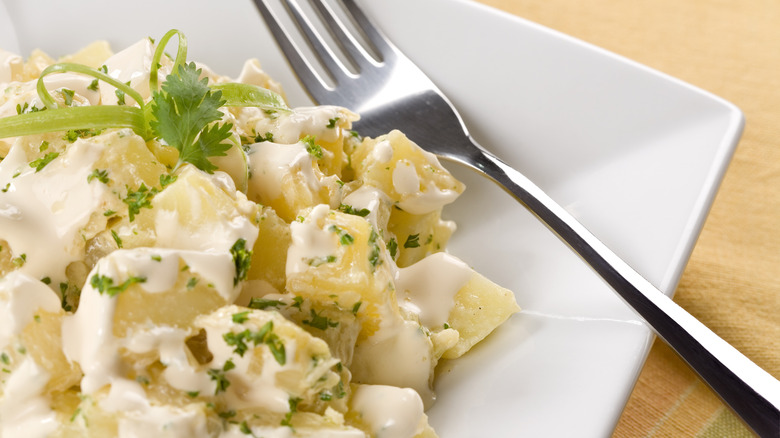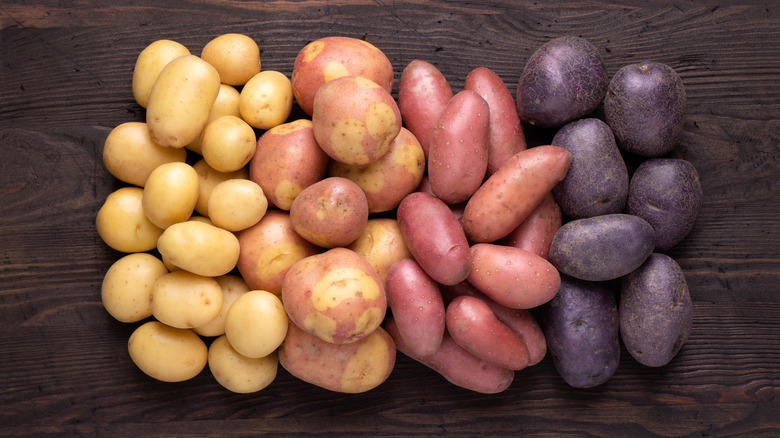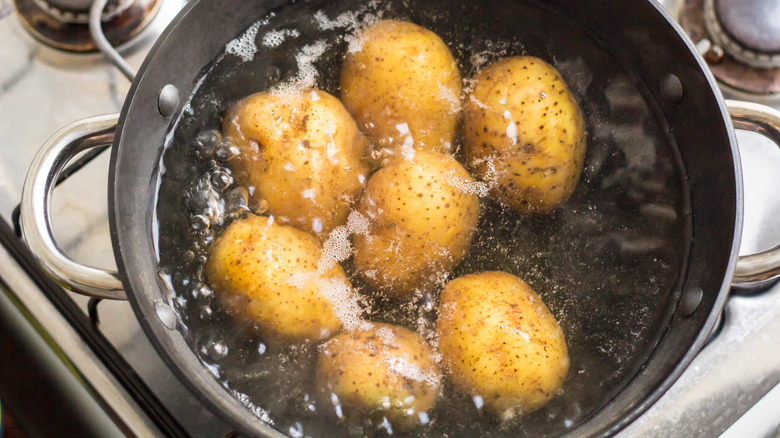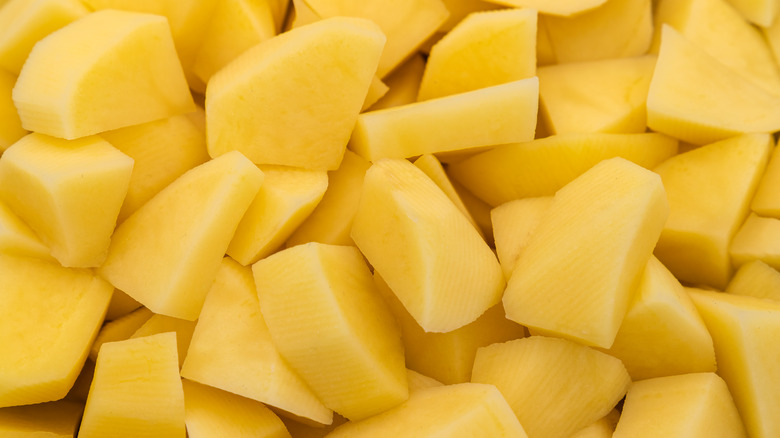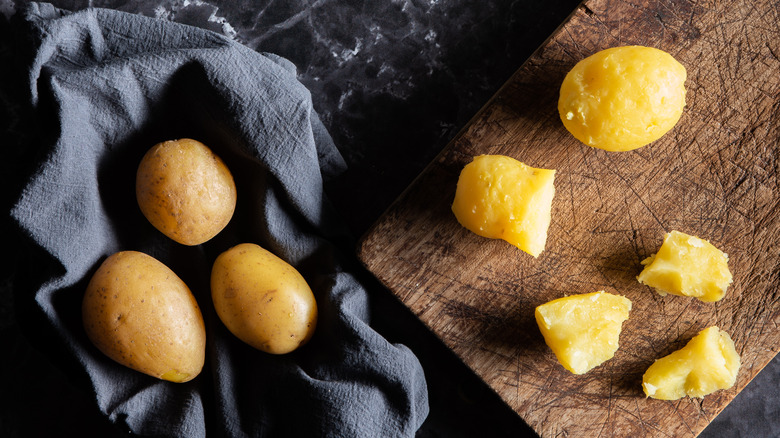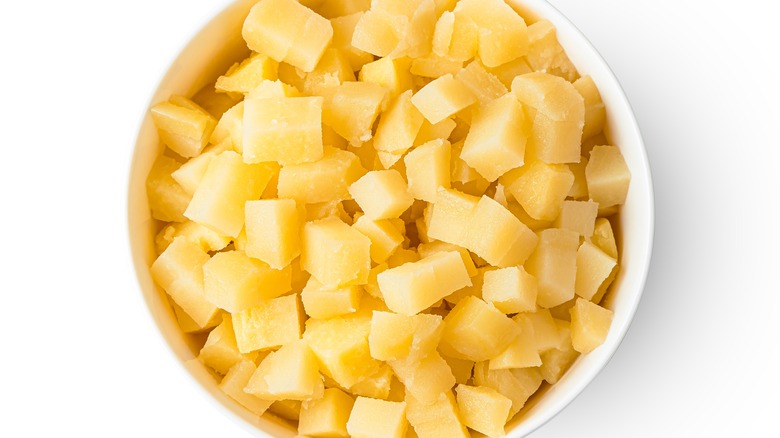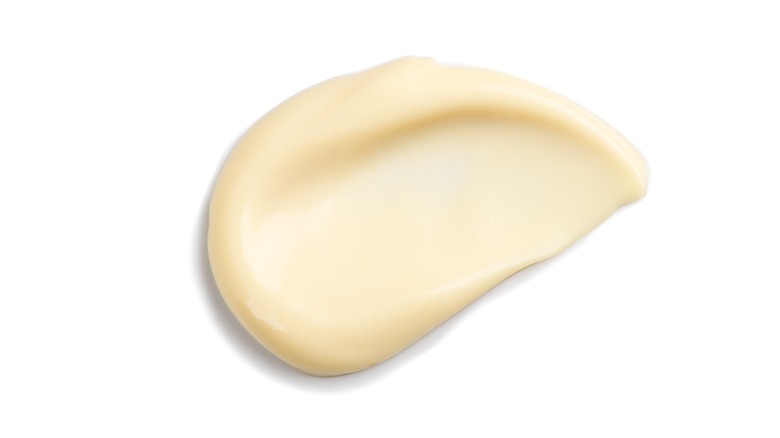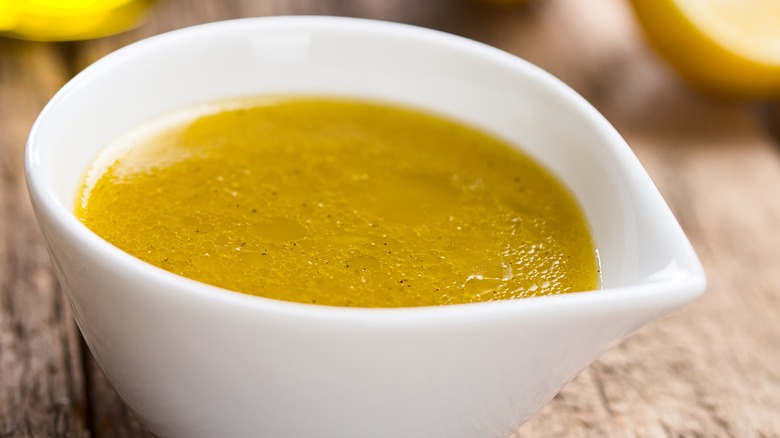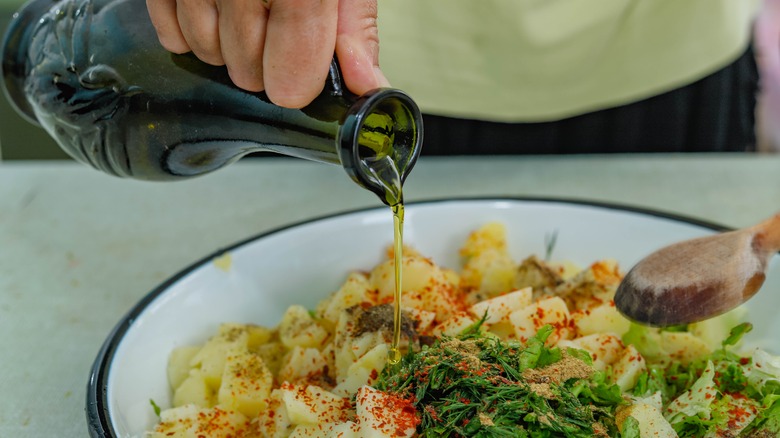9 Best Ways To Prevent Watery Potato Salad
Potato salad is that one dish you can depend on finding at summer picnics, outdoor parties, potlucks, barbecues, and family gatherings. From among the many possible picnic staple foods and recipes, this classic concoction is a perennial favorite for its creamy texture and tangy flavor. All the nostalgia and memories potato salad encapsulates are also a plus. We bet there are plenty of readers out there who can regale others about that single favorite potato salad, whether it was grandma's or aunt Susie's special recipe.
When it comes to the perfect recipe, there are two main opposing sides: Some prefer the classic mayonnaise-based version whereas others like the tang of a vinegar-based potato salad. Whichever salad you grew up eating, potato salad is one of those dishes that, if it's made incorrectly, it's almost unforgivable. A watery potato salad is something you want to avoid at all costs. To help you deliver the absolute best potato salad in texture and flavor, we've rounded up 10 ways to prevent potato salad from becoming watery.
1. Choose the right potato
Although most classic potato salad recipes call for russet potatoes — the potato that everyone thinks of when you hear the word potato — it doesn't mean that's your only option. There's an entire world of potato varieties out there for you to try and experiment with. If you find your potato salad comes out watery time and time again, it might be the perfect opportunity to try a different spud variety.
Here's where you could choose waxy potatoes over starchy ones. Try Yukon Gold, Red Bliss, or even fingerling potatoes. These varieties hold less moisture than their starchy russet cousin. Fingerling potatoes are a good choice because they cook up quicker especially if you're planning on boiling the potatoes whole for a more rustic-looking salad. Or, go for something out of the blue, and make your salad with purple potatoes to surprise everyone. Keep those russets for baked and mashed potato styles instead of potato salad.
2. Don't overcook the potatoes
When cooking your potatoes, they should be knife tender — nothing more and nothing less. Overcooking potatoes, especially the russet variety, can lead to potatoes that fall apart once you start mixing the potatoes with the other ingredients to make the salad. This is because the potatoes have absorbed too much water. You may even find yourself creating a mashed potato salad, which in itself might be a unique new rendition of potato salad, but that's not likely what you were going for in the first place.
But there's another option: Instead of boiling the potatoes, try steaming them! Place the whole, cubed, or diced potatoes in a steamer basket set inside a pot with a little bit of water in the bottom. Let the potatoes steam until they're easily cut by a knife. If you've overcooked potatoes in the past, try this cooking method to ensure your potatoes are cooked perfectly.
3. Cut the potatoes the same size
In the world of cooking, size does matter, especially when it comes to following a recipe as it's written. Cutting ingredients to a uniform size ensures everything cooks evenly and all at the same time. Unless the recipe calls for boiling the potatoes whole, it's really important to cut all your potatoes to the same size as specified in the recipe. And cook for the recommended amount of time while also checking the potatoes' tenderness.
In most cases the recipe will recommend cubing or dicing the potatoes — not wedges, quarters, or any other nonstandard shape. If the potatoes are cut into various sizes, like wedges or even slices, you will likely end up with a mix of overcooked and undercooked spuds. The dressing won't cling to the undercooked spuds, whereas the overcooked pieces will absorb a lot. You'll be left with a watery and chunky potato salad that won't be very pleasing for anyone to eat.
4. Cool the potatoes before assembling the salad
Most potato salad recipes call for the potatoes to be warm when you start assembling the salad. That's because the potatoes will do a better job of absorbing the dressing, leading to a much more flavorful potato salad overall. However, you don't want the potatoes to be hot straight out of the pot as that will inevitably melt a mayonnaise-based dressing. This will cause the potato salad to become way too wet and even oily since the heat may cause the mayonnaise to break, especially if you're using homemade mayonnaise.
Be sure to let the potatoes cool until they're easier to handle, almost room temperature. Then continue to assemble the salad. To cool the freshly cooked potatoes, lay them in a single layer on a tray, a platter lined with a kitchen towel, or directly on paper towels. They shouldn't be cold — just cool enough to the touch. This step will also speed up the salad's preparation time, which is always a plus.
5. Dehydrate potatoes before assembling the salad
Another trick you might try to prevent a watery potato salad is covering your just-boiled potatoes with a kitchen towel to let them steam and slightly dehydrate. Simply keep the potatoes in the colander you drained them in and cover them with a breathable towel. Let the potatoes stand until they're cool enough to handle.
Or, you could try dehydrating your potatoes after you've finished boiling them. This isn't as complicated as it may sound. You don't need any special equipment. Simply drain the potatoes over a colander, add the potatoes back to the pot you cooked them in, and then place the pot back over the burner on low. Let the potatoes release some of the steam from this additional blast of heat. Then let them cool on a tray lined with a kitchen towel or paper towels before continuing with the preparation of the potato salad.
6. Stick to real mayo
Whether you make your own mayonnaise or use your favorite brand to make potato salad, stick with the regular, full-fat mayonnaise. Although you may think it would be great to cut some calories and use the light mayo or the "salad dressing" in a jar, these lighter versions of mayonnaise tend to create a more watery dressing, especially when combined with other ingredients like mustard, vinegar, or lemon juice. The low-fat versions just don't keep their creaminess as much as regular mayonnaise does.
Now, we don't mean to keep you from trying something new in your potato salad. But instead of trying to reinvent a classic mayonnaise-based potato salad, how about trying a vinegar and mustard-based potato salad recipe if you're trying to create a lighter version? It may not be quite the same crowd-pleaser as the traditional potato salad, but it will have its set of fans, too.
7. Be careful of how much liquid you add
You may be tempted to get extra creative with your potato salad—that is if you're willing to risk your family's wrath. Some reinvented potato salads even call for adding pickle brine or relish to the dressing, like in this Southern potato salad recipe. Cool! Although you're free to do so, be wary that experimenting too liberally may cause your potato salad to become watery.
You might try supplementing regular mayonnaise with a little sour cream or yogurt to test the consistency first. And, of course, the more vinegar and lemon juice you add, the higher your chances of the potato salad turning out watery. You might try adding a little liquid at a time, maybe even less than the recipe calls for. You can also drain relish before adding to the salad.
Remember, you can always add more, but you can't take back what you've already added! If you're determined to reinvent your potato salad, try adding fresh herbs like dill to create something different without changing the dressing thickness.
8. Mix the potato salad with a light touch
You may be so excited to combine the ingredients for your potato salad that you go about mixing everything with so much gumption that you end up with a starchy soup. That's not the way to mix potato salad. Put aside the wooden spoon! The secret is folding: Just like you would fold beaten egg whites into a cake batter, it's best to fold your potato salad with a light touch.
Make sure you use a large bowl with enough room to fold properly. First, make the dressing in this bowl. Then, using a spatula or a large metal spoon, gently fold your potatoes and any other ingredients into the dressing. Avoid mixing the ingredients vigorously. This will ensure the potatoes won't break down into mashed potatoes and ruin the entire consistency of the potato salad. No one wants watery and starchy potato salad!
9. Chill immediately after you make the potato salad
Refrigeration is the last step in turning out a good potato salad, as it will firm up its consistency and prevent it from getting runny —not to mention it will reduce any risk of bacterial growth and, as a result, food poisoning. After making your potato salad, transfer it to a container with a tight-fitting lid and refrigerate for at least 1 hour or even overnight if you have the time. This will give the potato salad some time to set, for the potatoes themselves to absorb more of the dressing, and you'll also have a pleasantly chilled salad.
Another important thing to note: Don't leave the potato salad at room temperature for too long. This is something that often happens at family gatherings and backyard cookouts — the potato salad has been forgotten for hours upon hours, and sometimes in the sun where it will just end up watery and oily (as well as dangerous to eat). Don't leave the potato salad out of the refrigerator for more than two hours.
